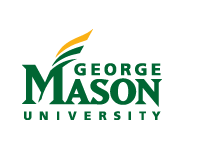- Funny Facebook Groups
- A Bundle of George
- New Mascot Shows His Patriot Pride
- Partners in Crime Investigation
- Mason Establishes Endowed Chair in Islamic Studies
- New Clinic Pairs Dance Students and Athletic Trainers
- Top Five: Ways to Shed Those Extra Pounds
Funny Facebook Groups

Obama-rama
President Barack Obama chose Mason’s Center for the Arts Concert Hall to give an invitation-only speech on January 8. The then-president elect spoke to hundreds in attendance about his new economic plan.
With more than 150 million active users, Facebook has become the go-to social utility for classmates and coworkers wanting to keep in touch. So it’s no wonder that a few jokers have started their own humorous groups with Mason in mind. Here are a few of our favorite funny Mason-themed Facebook groups.
Lindey Is the Coolest Pet at George Mason University. Started by Lindey’s humans, Tiffany and Brad Menard, who both work in University Housing and Residence Life, this group celebrates one dog’s awesomeness.
In Search of a Nonpsycho Roommate Fall 2009 George Mason University. Ah, what ingenuity. One person has started up a group for people wanting to find their own roomie matches.
Have You Seen That Guy Wandering GMU in a Kilt? Though we don’t have direct experience with the person of whom this group speaks, there is photographic proof of said guy in kilt on this page.
Zombie Defense League: George Mason Univesrity [sic] Chapter. According to this Facebook group, “GMU is a prime setup to maintain and stop an impending class two–three (out of four) zombie attack.” They’re kidding … we hope.
And, of course, don’t forget to join our Facebook group, Friends of the Mason Spirit, while you’re checking these out online. You’ll be able to touch base with other Spirit readers and get updates on our online-exclusive stories. You can find links to our Facebook group and Twitter feed at spirit.gmu.edu.
A Bundle of George
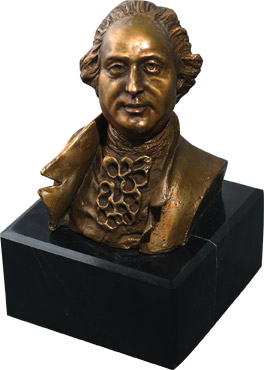 At 6 pounds, 8.5 ounces, and measuring just 6.5 inches tall,
the littlest member of the Mason family is the Mason bust. Generally presented to individuals who
have made a lifetime commitment
of more than $1 million to the university, this little guy is a rare
find indeed.
At 6 pounds, 8.5 ounces, and measuring just 6.5 inches tall,
the littlest member of the Mason family is the Mason bust. Generally presented to individuals who
have made a lifetime commitment
of more than $1 million to the university, this little guy is a rare
find indeed.
The busts were initially proposed as part of the major donor recognition plan for the first comprehensive campaign. In July 1998, 30 of the busts were made, and to date 11 have been given out by the Office of University Development and Alumni Affairs. The first bust was presented to President Alan Merten on November 30, 1998; the first bust presented to a donor went to Sidney Dewberry and his wife, Reva, on December 9, 1998.
And if you’re thinking that this little one bears a striking resemblance to the George Mason sculpture that presides over the Fairfax Campus, it’s because the two are related. The bust is based on the maquette, or the scale model, of the larger sculpture that stands in front of the Johnson Center, which was commissioned in 1995 and dedicated on April 12, 1996. The bust was executed by the same sculptor, Wendy M. Ross.
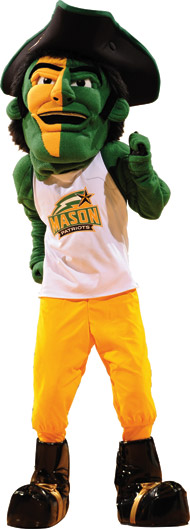 New Mascot Shows
His Patriot Pride
New Mascot Shows
His Patriot Pride
The Mason Nation has a wealth of school pride and now a new mascot that reflects that abundance. The mascot, named “The Patriot,” was unveiled at the first home game of the season, where he led the cheering charge at the basketball game that ended in a win over Brown University.
Gunston, the familiar former mascot of the green-and-fuzzy variety, gained a lot of visibility after Mason’s 2006 appearance in the Final Four, says University Relations vice president Christine LaPaille. But the question arose as to whether he was up for the job, so LaPaille put together a panel to assess whether it was time for Gunston to step down.
“The panel did a great job in recognizing that while [Gunston] isn’t an ideal mascot for Mason today, he can still have a role that capitalizes on that association,” LaPaille says.
That’s right; Gunston will still be around campus. After a make-over, he will be the university’s green ambassador, appearing at events promoting Mason’s environmental initiatives.
Partners in Crime Investigation
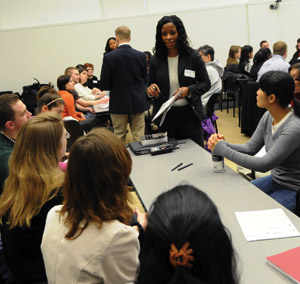 This winter, 40 School of Management students partnered with
Internal Revenue Service-Criminal
Investigation Division (IRS-CID) special agents to learn what it takes to convict a criminal. After all, let’s not forget that it was the work of the IRS that led to notorious mob boss Al
Capone’s downfall.
This winter, 40 School of Management students partnered with
Internal Revenue Service-Criminal
Investigation Division (IRS-CID) special agents to learn what it takes to convict a criminal. After all, let’s not forget that it was the work of the IRS that led to notorious mob boss Al
Capone’s downfall.
Students in the Accounting Honors Program and those pursuing an accounting certificate became honorary special agents for the day to solve a mock fraud case as part of a program known as the Adrian Project. This was the first time Mason had participated in the program.
“The Adrian Project is a unique opportunity for accounting students to explore the possibility of a career in criminal justice and learn about the inner workings of fraud investigation through the eyes of an IRS special agent,” says Anne Magro, associate professor of accounting and director of the Accounting Honors Program.
During the exercise, students were split into groups to perform the investigation, which took several hours to complete. The simulation began with an “informant” reporting suspicious activity to the special agents, who allowed the students to use forensic accounting tools used by federal law enforcement officers. Throughout the investigation, students played the roles of informant, special agents, undercover agents, and, ultimately, arresting agents.
“This was definitely a worthwhile use of our time today. It was really interesting to see how accounting can be used within the law enforcement context,” says Mason junior Benjamin Smith.
Mason Establishes Endowed Chair in Islamic Studies
To position itself as a leading authority in the field of Islamic studies, Mason is recruiting an expert in that discipline. Last November, Mason received a $1.5 million gift from the International Institute for Islamic Thought (IIIT) to hire a leading scholar to serve as an endowed chair in Islamic Studies.
Based within the College of Humanities and Social Sciences (CHSS), the new chair will work toward developing a multidisciplinary academic program with teaching, research, and public outreach. Says CHSS dean Jack Censer, “As this appointment focuses on Islam from a global perspective, it will facilitate more teaching and scholarship in an area that the university has already identified as a spire of excellence.”
IIIT is a nonprofit organization dedicated to promoting awareness of Islamic thought and contemporary social sciences. The gift will help Mason lead the way in the study of Islam and Muslim societies, says IIIT vice president Jamal Barzinji.
“The study of Islam within the context of a global human civilization is essential to an understanding of the critical issues of our time,” Barzinji says.
The program will stem from the interdisciplinary minor in Islamic studies and Middle East studies that Mason currently offers.
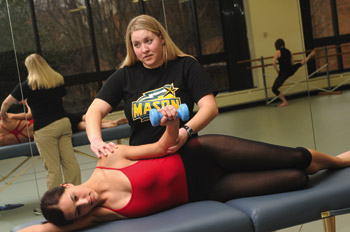 New Clinic Pairs Dance Students
and Athletic Trainers
New Clinic Pairs Dance Students
and Athletic Trainers
Joining just a handful of others around the country, Mason’s College of Visual and Performing Arts (CVPA) and College of Education and Human Development (CEHD) have joined together to start a performing arts medicine clinic.
The clinic is currently available to all dance majors in CVPA and the in-house athletic trainer is the first point of contact for dancers looking to increase their strength and rehab from minor injuries. Stephanie Symons, a graduate student in the School of Recreation, Health, and Tourism within CEHD and a nationally certified and state-licensed athletic trainer, staffs the clinic.
“Students realize the importance of tracking the progress of their recovery and have been very receptive to the clinic,” says Symons.
Most students go to Symons with sprained ankles or strained muscles, but Christina Lydia Salgado was looking for help with an injured hip. Symons developed exercises for Salgado to complete in a swimming pool so there was less stress on her hip joint.
“I was able to work with someone right in the department, which made the process easier,” says Salgado. “[Symons] also can guide us through the healing process, which is very important, since we all want to be able to perform to the best of our ability in our dance classes.”
Top Five: Ways to Shed Those Extra Pounds

Lisa Pawloski
We’re beginning a new tradition here at the Spirit. With the great access we have to some of the top experts in their respective fields, it made sense to have Mason professors share a bit of their knowledge with our readers. So we’re starting the Top Five, in which we’ll ask a leading authority in a subject—any subject—to give us the skinny. We kick off the inaugural Top Five with Lisa Pawloski, chair of the Department of Global and Community Health and a nutritional anthropologist. Here are her top five ways to maintain a healthy weight:
1. Limit eating at restaurants.
If you do eat out, share a plate or take half home.
Most research suggests that people who dine out consume approximately 200 additional calories at each meal compared with those who prepare their meals at home. Not only are foods prepared at restaurants typically high in calories, but they are often higher in fat and sodium and portions are typically too large.
2. Eat with other people and not in front of the TV.
Socializing often helps to limit calories—particularly if you are quite chatty— but also creates an atmosphere that slows down your intake of food. Those who eat more slowly tend to eat fewer calories. Also, dining in front of the TV has been linked to increased caloric consumption and can create a Pavlovian-like association so that you may feel hungry each time you watch TV.
3. Small calorie snacks and beverages add up. Cut out one small habit and add another small good habit.
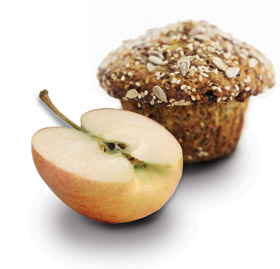 Most people don’t realize how cutting out small calories can make
a big difference in weight loss. It takes 3,500 calories to make a pound of fat. If you consume one 150-calorie soda every day and cut that soda out, you would lose 15 pounds of fat in one year. By the same token, adding small increments of exercise can make a big difference, too, particularly those lifestyle changes that can be permanently integrated into your day, such as taking the stairs instead of the
elevator. Interestingly, these small changes in energy expenditure may have contributed significantly to our obesity crisis. Think about all the technologies you have that your parents and grandparents did not, such as garage door openers, electric windows, TV remote controls, wireless personal phones, and
microwave ovens. Rolling up and down your car window every day for a year could take off five pounds.
Most people don’t realize how cutting out small calories can make
a big difference in weight loss. It takes 3,500 calories to make a pound of fat. If you consume one 150-calorie soda every day and cut that soda out, you would lose 15 pounds of fat in one year. By the same token, adding small increments of exercise can make a big difference, too, particularly those lifestyle changes that can be permanently integrated into your day, such as taking the stairs instead of the
elevator. Interestingly, these small changes in energy expenditure may have contributed significantly to our obesity crisis. Think about all the technologies you have that your parents and grandparents did not, such as garage door openers, electric windows, TV remote controls, wireless personal phones, and
microwave ovens. Rolling up and down your car window every day for a year could take off five pounds.
4. Choose nutrient-dense calories that you enjoy. If the dessert isn’t really good, it’s not worth the calories.
An interesting study done in Sweden compared a group of Thais eating Thai food with a group of Thais eating Swedish food, and a group of Swedes eating Swedish food with a group of Swedes eating Thai food. When Thais ate Thai food and Swedes ate Swedish food, it was found they secreted more digestive enzymes and absorbed more nutrients. Lesson learned?
Eat foods that you are comfortable with and enjoy.
5. Try soup before your meals and try gum in between.
Recent studies have shown that warm soup before a meal fills the stomach and individuals consume less during the meal. Furthermore, those who chew gum, which basically creates a flavor in the mouth, have been found to better avoid high-calorie snacks in between meals.

